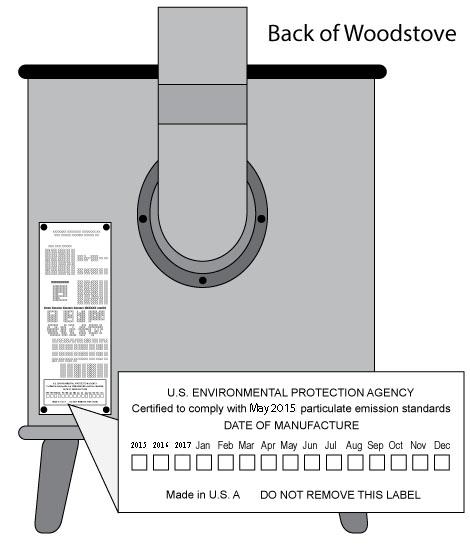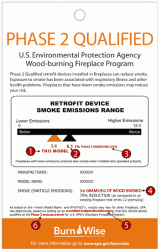Choosing Wood-Burning Appliances
When choosing your wood burning appliance, consider efficiency, emissions, and the size of the space you'll be heating. The cleanest wood-burning appliances are marked with EPA-certified and EPA-qualified labels.
Your local hearth retailer can help you make the best choice and provide you with options to suit your needs and budget.
- Types of wood-burning appliances
- What is the difference between an EPA-certified and EPA-qualified appliance?
- Alternative wood-heating options
- Additional resources
Types of Wood-burning Appliances
If you choose to heat your home with wood, use the cleanest wood-burning appliance possible. People heat their homes with a variety of appliances – either as a primary source of heat, as supplemental heat, or for ambiance.
- Wood stoves
A wood stove is a type of wood heater that is usually made of cast iron or steel. Wood stoves that burn wood for fuel can be used as a primary or secondary source of heat.
Learn about choosing the right wood stove. - Fireplace inserts
Fireplace inserts are similar in function and performance to free-standing wood stoves, but are designed to be installed within the firebox of an existing masonry or metal fireplace. A certified installer will make sure the flue liner in your masonry chimney is installed correctly. If your fireplace is factory built (or "zero-clearance"), you must use an insert that was specifically designed and tested for your unit to make it more efficient and less polluting.
- Pellet stoves
Pellet stoves are similar in appearance to wood stoves; however, instead of wood, pellet stoves burn a renewable fuel made of ground, dried wood and other biomass wastes compressed into pellets. Pellet stoves operate by pouring pellets into a hopper which feeds automatically into the stove. Unlike wood stoves and fireplaces, most pellet stoves need electricity to operate.
Learn more about pellet stoves. - Fireplaces
There are two major types of wood-burning fireplaces, traditional masonry fireplaces and pre-fabricated “low mass” fireplaces. Most fireplaces, whether masonry or low mass, are not used as a primary source of heat; their function is primarily for ambiance and secondary heating.
Learn about choosing the right fireplace. - Fireplace retrofits
A fireplace retrofit is a device that is installed into an existing wood-burning fireplace. The primary purpose of the retrofit is to reduce wood smoke pollution from existing fireplaces. If installed and operated properly, fireplace retrofit devices can reduce pollution by approximately 70%.
Learn more about fireplace retrofits. - Hydronic heaters
Hydronic Heaters (also called wood boilers, pellet boilers, outdoor boilers, and outdoor water stoves) burn wood fuels such as cord wood, wood pellets, wood chips, or corn. Heat is transferred to either water or a water/anti-freeze solution, which is piped to the area being heated. Hydronic heaters are located either inside or outside the buildings they heat.
Learn about choosing the right hydronic heater. - Forced-air furnaces
Forced-air furnaces (also known as warm-air furnaces) are designed to burn cordwood, wood pellets or wood chips to heat an entire residence. Heat from these furnaces, which are typically located indoors, is distributed through ducts using a blower fan. Stacks or chimneys for these furnaces are generally on the roof of the home they heat. Large forced-air furnaces are capable of outputting 65,000 BTU per hour or more while small forced-air furnaces output less than 65,000 BTU per hour. Find EPA-Certified forced-air furnaces.
- Masonry heaters
A masonry heater is a site-built or site-assembled solid-fueled heating device, consisting of a firebox, a large masonry mass, and a maze of heat exchange channels. It stores heat from rapidly-burning fires within its masonry structure, and slowly releases the heat into the home throughout the day. Masonry heaters currently do not require EPA certification. The Masonry Heater Association of North America Exitcan provide you with more information on masonry heaters and installers near your area.
What is the Difference between an EPA-certified and EPA-qualified Appliance?
An EPA-certified appliance must meet regulatory emission requirements established by EPA. After May 15, 2015, the following appliances must meet regulatory emission limits:
- Wood and pellet stoves (including fireplace inserts)
- Fireplace inserts
- Hydronic heaters (outdoor wood boilers)
- Forced air furnaces (was effective May 15, 2016 for small units and May 15, 2017 for large units)
manufacturers may choose to meet voluntary EPA emission standards. Appliances meeting these requirements are "EPA-qualified," and burn more cleanly than older, unqualified models. Check with your state or local air quality agency to determine the types of wood-burning appliances that are approved for use in your area.
Alternative Wood-heating Options
In addition to wood-burning appliances there are also alternative heating options, including:
- Gas stoves
Gas stoves are designed to burn either natural gas or propane. They emit very little pollution, require little maintenance, and can be installed almost anywhere in the home. Today’s gas stoves can be vented through an existing chimney, or direct vented through the wall behind the stove. While some models do not require outside venting, EPA does not support their use due to indoor air quality concerns. For more information, see the U.S. Department of Energy webpage on Gas furnaces and boilers. Exit
- Decorative fireplace gas logs
Decorative fireplace logs can be installed in an existing fireplace. While not designed to be a significant source of heat, decorative logs provide an alternative to burning wood. Because they burn either natural gas or propane, they have low pollution emissions.
Additional Resources
The following websites provide additional information to help you choose the best heating option for your home.The following links exit the site Exit
- Alliance for Green Heat - Information on choosing appliances and federal and state policies.
- Hearth.com - Find hearth products and have your hearth questions answered.
- How much heat does that room need? - Estimate the amount of BTUs required to heat a room by entering in the room’s dimensions.
- Fuel cost comparison calculator.
- Hearth, Patio and Barbecue Association (HPBA) - Information for outdoor wood heaters, wood stoves and other related industries
- HPBA's Responsible Wood-burning Fact Sheets - Responsible wood burning provides efficient and economical home heating, helps reduce home energy costs, and protects your neighborhood air quality.
- Pellet Fuels Institute (137k) - This calculator compares costs of using different fuel types, including wood, gas, oil, and electric.
- US Energy Information Administration - Learn more about comparing the cost of different heating fuels.
- Wise Heat - Alternative heating reviews.


